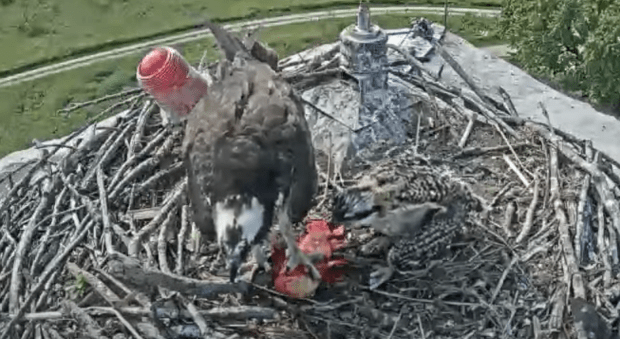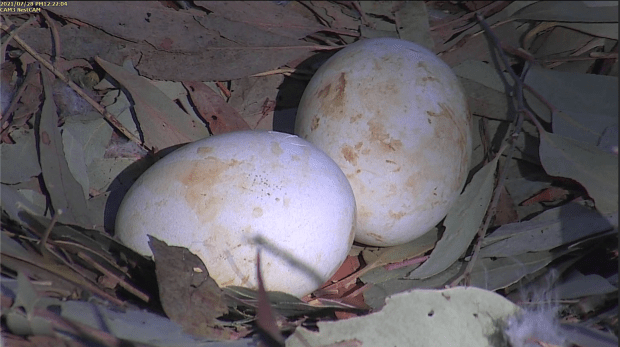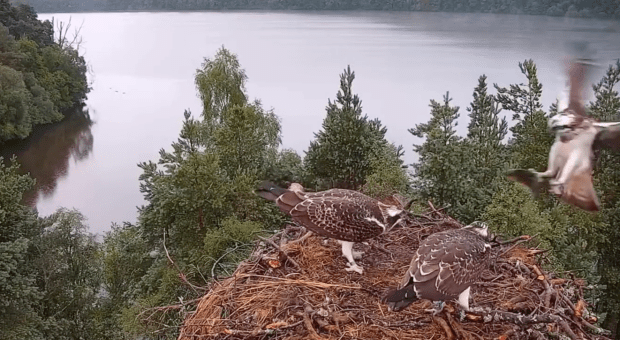Every once in awhile I hear from one of my former students. It is always a treat. Yesterday a letter popped into the inbox from Taiwan. This student was excited when I wrote about the Black Kite nest in the cemetery near Taipei but on Monday, they said that their absolute favourite raptor is the Oriental Honey Buzzard. The Honey Buzzards live in the high mountains and unlike other raptors who eat meat, birds, or fish, the Oriental Honey Buzzard eats bee pupae. Bee Pupae is the third stage in the development of the bee with the first being the egg, then the larvae, the pupae, and then finally the adult honey bee. Honey Buzzards are from the Genus Pernis. This includes the Western Honey Buzzard that lives in Europe, the Middle East, and Africa , the Barred that lives in the Philippines and Sulawesi, and then the Oriental whose nests are in eastern Asia including Taiwan.
Just look at the beautiful colouring. The female is larger than the male; they range from 57-61 cm long (or at the maximum a little over 2 ft). The wing span is 121-135 cm or at their maximum 4.5 ft. The head is smaller in proportion to the body than many raptors.

In the image below, you can see the Oriental Honey Buzzard being swarmed by the bees in the colony after it has take a portion of honey comb.

I am just learning about this very interesting raptor. They are quite beautiful. There are several YouTube videos. The shortest is interesting but the images are not clear. The longer one has gorgeous images of all the animals that live in the forest with an excellent introduction into this amazing raptor. Enjoy at your leisure!
As you might know, I have been hoping to get a glimpse of Tiny Little (or Little Bob) at the Foulshaw Moss Osprey Nest in Cumbria. She has alluded me. Still awake at 2am I decided to check on that nest – and guess what? There was Tiny Little doing what she does best – trying to take a fish from one of her older siblings. Tiny Little tried her normal tactics including wing flapping the older sib who decided to wing flap back!


After the older sibling got tired of Tiny Little’s activities, it took the fish and flew away. Tiny Little then did what she does best. She found all kinds of fish that the bigger sibling had lost in the nest! Well done Tiny Little!

Malin, the chick on the Collins Marsh Nature Centre’s Osprey Nest had at least two feedings this morning. I was running in and out and did not rewind to dawn. The feather issue appears to be a missing/yet to be developed primary feather but I am not an expert.
Malin’s feathers might be late growing in. We continue to be optimistic. Despite the fact that the fish are small, they are coming in to the nest and she appears to be eating well and growing.

You can see how that section of Malin’s wing hangs in a worrisome way.

The joint between the upper wing or patagium and the primaries is called the wrist. The feathers of the upper wing are growing nicely and every day the tail appears longer.

OTHER NEST NEWS:
Blue 494 fledged today at the Pont Croesor nest at Glaslyn, 50 days old. 494 is the son of Blue 014 and Z2 (Aeron). He has great DNA! Congratulations to everyone.
Zenit continues to grow into the most beautiful Golden Eagle in Bucovina, Romania. He has been sharing parts of a deer with his mother and Zenit has the most enormous crop. I would love to see this size of crop on Malin!

The colour of the plumage is simply gorgeous. It has been a real privilege to see this Golden Eagle grow from a tiny bobble.

Hopefully the little sea eagles, 27 and 28, will grow and be nice to one another. Dad has been sharing in some of the brooding and Lady and Dad have both fed the babies. Postings on FB say that Lady fed the chicks ten times today! There is no shortage of food although some are giggling that they do not particularly like Bream. Interesting.

Gough Island Restoration. The second bait application is now complete. The drive to eradicate the mice and rats killing the Tristan and Sooty Albatross got a break in the weather and completed their mission. We will be looking forward to a wonderful assessment.
That is it for today. Tomorrow I am heading out to attempt another day of ‘bird photography’. This could become a running joke. I had forgotten how heavy big lenses are. Wish me luck.
Thank you for joining me today. If you did not know about the Honey Buzzard, I hope you found those birds quite interesting. Take care. Tomorrow we will catch up on what is going on with the storks in Latvia and Estonia and with Big Red and the Ks.
Thank you to the following for their streaming cam where I took my screen shots: Sea Eagle Cam, Birdlife Australia, and the Discovery Centre, Collins Marsh Nature Centre Osprey Cam, Cumbrian Wildlife Trust and the Foulshaw Moss Osprey Nest, and the Bucovina Golden Eagle Cam.










































